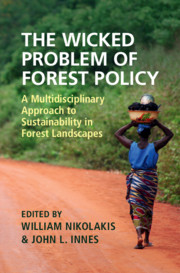 The Wicked Problem of Forest Policy
The Wicked Problem of Forest Policy Book contents
- The Wicked Problem of Forest Policy
- The Wicked Problem of Forest Policy
- Copyright page
- Contents
- Contributors
- 1 The Wicked Problem of Forest Policy
- Part I Wicked Problems and Policies
- Part II Tools to Address Wicked Problems
- 9 The Wicked Problems of Indonesia’s Forests Require Effective Institutions to Resolve Difficult Trade-Offs
- 10 Power to the Forest People
- 11 How Are Land-Use Multi-stakeholder Fora Affected by Their Contexts?
- 12 Sustainable Landscape Investment
- 13 Community Forestry in Liberia
- 14 Are Some Forestry Problems Too Wicked?
- Index
- References
11 - How Are Land-Use Multi-stakeholder Fora Affected by Their Contexts?
Perspectives from Two Regions of the Peruvian Amazon
from Part II - Tools to Address Wicked Problems
Published online by Cambridge University Press: 24 July 2020
- The Wicked Problem of Forest Policy
- The Wicked Problem of Forest Policy
- Copyright page
- Contents
- Contributors
- 1 The Wicked Problem of Forest Policy
- Part I Wicked Problems and Policies
- Part II Tools to Address Wicked Problems
- 9 The Wicked Problems of Indonesia’s Forests Require Effective Institutions to Resolve Difficult Trade-Offs
- 10 Power to the Forest People
- 11 How Are Land-Use Multi-stakeholder Fora Affected by Their Contexts?
- 12 Sustainable Landscape Investment
- 13 Community Forestry in Liberia
- 14 Are Some Forestry Problems Too Wicked?
- Index
- References
Summary
Multi-stakeholder mechanisms have been touted as a more democratic and equitable alternative to forest and land use decision-making. It has been argued that these processes do not address power relations and thus maintain the status quo. In this chapter, we examine eight Multi-stakeholder fora in the Peruvian Amazon, half of which have been set up in the Madre de Dios region, and the other half in the San Martin region, both in the Peruvian Amazon. These regions represent two different poles of development paradigms in Peru. While the chapter does not provide a definitive answer around whether multi-stakeholder processes can address power inequalities, three preliminary ideal types are used to analyze these mechanisms, drawn from a realist synthesis review of the literature: decision-making, management and influence. This chapter illuminates how multi-stakeholder fora are affected by their contexts, as well as their process and outcomes.
- Type
- Chapter
- Information
- The Wicked Problem of Forest PolicyA Multidisciplinary Approach to Sustainability in Forest Landscapes, pp. 301 - 327Publisher: Cambridge University PressPrint publication year: 2020
References
- 2
- Cited by
